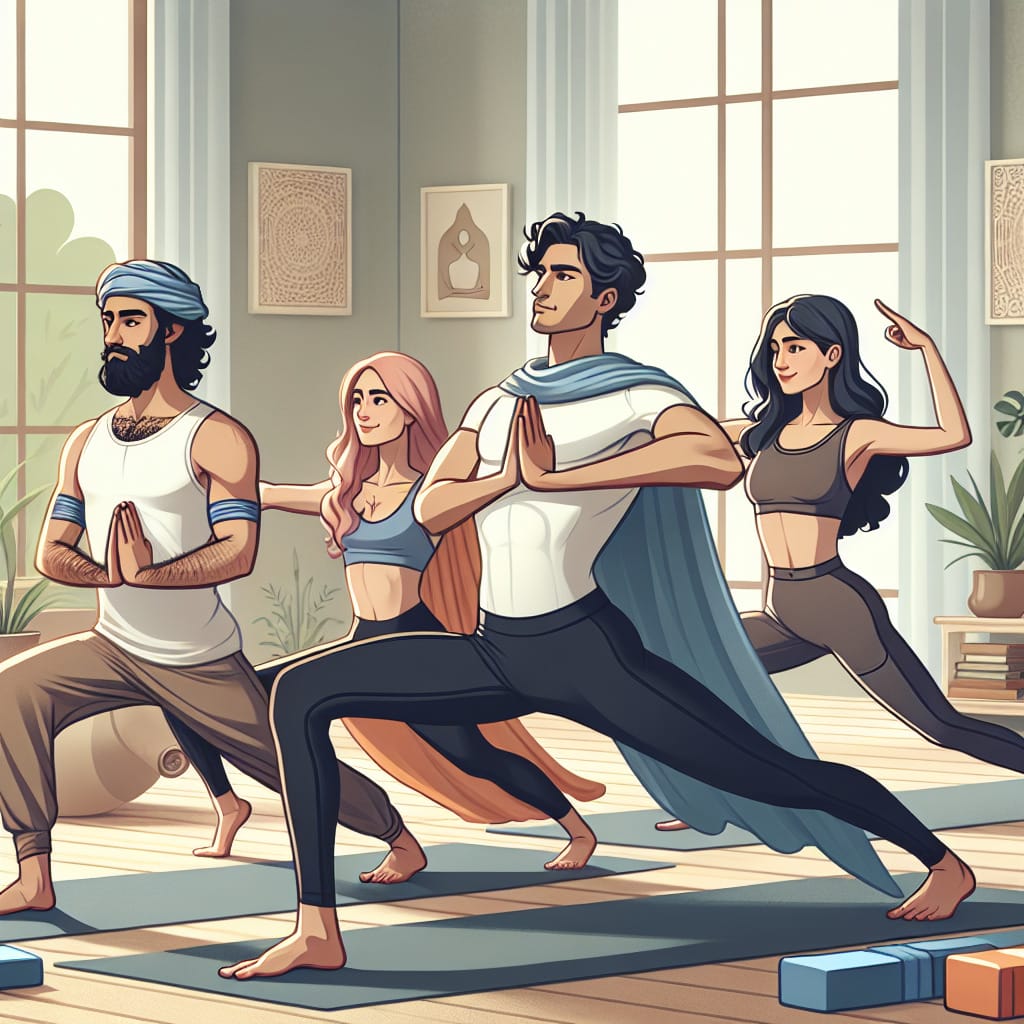
Mastering the Hero Pose: A Comprehensive Guide in Yoga
Table of Contents
- Introduction
- History and Origin of the Hero Pose
- Benefits of the Hero Pose
- Step-by-step Guide to the Hero Pose
- Modifications and Variations of the Hero Pose
- Conclusion
- Frequently Asked Questions
Introduction
The Hero Pose, known as Virasana in Sanskrit, is more than just a simple sitting posture. This yoga sequence does not only improve your sitting posture, but it also stretches your thighs and feet for maximum stretch. A regular practice of the hero pose can enhance alignment making initially difficult poses feel more comfortable over time. For yoga teachers aiming to guide students into this meditative pose effectively, remember that proper alignment is crucial to avoid injury. Encourage them to place their hips between their heels with their feet flat on the floor. If they find this alignment difficult or experience discomfort in the knees or ankles, they may make use of props like yoga blocks or a rolled blanket under the sit bones for extra support while still getting a gentle pressure on the calf muscles for an effective stretch. Practicing this pose slowly brings greater awareness to internal rotation of thigh muscles and helps in maintaining proper hip joint health too.
History and Origin of the Hero Pose
The Hero Pose, or Virasana, traces its origins back to the ancient practice of yoga in India. The term ‘Virasana’ is derived from two Sanskrit words – ‘Vira’, which means hero or warrior, and ‘Asana’, meaning pose. The essence of this pose reflects the courage and strength of a hero, symbolizing inner bravery and resilience. This seated posture has evolved over centuries; initially appreciated for its calming effects on the mind during meditation, it’s now recognized for its numerous physical benefits too. In recent times, yoga teachers have also incorporated variations like the wide Hero Pose into their yoga sequences to maximize stretch and improve alignment. However, despite these modifications, the true essence remains: achieving a state of balance internally while grounding our entire body externally.
Benefits of the Hero Pose
Practicing the Hero Pose, or Virasana, is not only beneficial for improving posture but also vital to mental wellness. A regular practice of this pose can be transformational as it provides a maximum stretch to thigh muscles and calf muscles, bringing therapeutic relief from day-to-day stress. This meditative pose enhances focus and tranquility as you are guided to keep your entire body grounded while maintaining proper alignment. It’s the subtle shift of weight onto your sit bones that helps alleviate pressure on your hips and knees, making it an ideal pose for those seeking comfort in sitting postures. Yoga teachers often recommend utilizing yoga blocks if alignment is difficult or using a rolled blanket under the sit bones for added support while ensuring feet remain flat on the floor. For variation, adopting a wide hero pose can bring greater awareness and flexibility to one’s yoga sequence. Remember that like any other yoga poses, Virasana should be practiced under proper guidance to avoid injury and achieve correct alignment eventually sitting comfortably between your heels with the gentle pressure being exerted on your feet slightly wider than hip distance apart.
| Key Benefit | Description |
|---|---|
| Improves Posture | Practicing the Hero Pose can help in improving posture. |
| Mental Wellness | Regular practice of this pose is vital for mental wellness as it enhances focus and tranquility. |
| Stretches Muscles | Provides a maximum stretch to thigh and calf muscles. |
| Relieves Stress | Brings therapeutic relief from day-to-day stress. |
| Improves Alignment | Guides to keep the entire body grounded while maintaining proper alignment. |
| Alleviates Pressure | Helps alleviate pressure on hips and knees, making it an ideal pose for those seeking comfort in sitting postures. |
| Supports Variation | A wide hero pose can bring greater awareness and flexibility to one’s yoga sequence. |
| Prevents Injury | Like any other yoga poses, Virasana should be practiced under proper guidance to avoid injury. |
Step-by-step Guide to the Hero Pose
The Hero Pose, or Virasana, is a cornerstone of the yoga practice, offering an array of benefits from improving posture to enhancing mental wellness. As you kneel down and sit your hips back between your heels, with feet slightly wider than hip-width apart, you’ll find that this pose imparts a gentle pressure to your sit bones and calf muscles providing maximum stretch. This position helps in maintaining proper alignment for those with knee and ankle discomfort. The true essence of practicing Virasana lies in experiencing that internal rotation of thigh muscles leading to greater awareness about one’s body alignment. By ensuring that your feet are flat on the floor while sitting bones carry most of the weight, we can avoid common mistakes like undue strain on knees or ankles. Utilize yoga blocks or a rolled blanket under sit bones if finding alignment is difficult in order to achieve maximum benefits safely from this ancient yogic pose without any injury. For those looking for more flexibility in their routine, variations like wide hero pose can add another level of depth to their regular hero pose yoga sequence.

Modifications and Variations of the Hero Pose
As we delve deeper into the exploration of the Hero Pose or Virasana, it becomes evident that this pose offers a spectrum of variations catering to both beginners and seasoned yogis. For those just embarking on their yoga journey, modifications using yoga blocks under the sit bones can provide support and make alignment less difficult, fostering an enjoyable experience while practicing the hero pose. It’s important to note that each yogi should listen to their own body during this practice; if you feel any discomfort in your knees or ankles, don’t hesitate to use props like a rolled blanket for added comfort. Meanwhile, advanced practitioners can challenge themselves with variants such as the wide hero pose. This variation provides a greater stretch in thigh muscles and calf muscles while enhancing awareness of one’s body alignment – truly reflecting the essence of Virasana. While these adaptations range from gentle pressure on sit bones for beginners to extensive stretch for experienced yogis, they all lead towards improving posture and mental wellness through regular practice.

Conclusion
Embracing the age-old wisdom of yoga, the Hero Pose (Virasana) brings to light its distinctive charm. It’s not just another pose in your yoga sequence; it’s a display of strength and resilience symbolic of a hero. Though this sitting posture might seem simple, practicing it regularly bears fruits for both physical and mental wellness. The alignment of sit bones carrying the weight while feet lay flat gives a gentle pressure on calf muscles providing maximum stretch —ideal for improving posture. For beginners finding alignment difficult, using yoga blocks or rolled blankets can be helpful while experienced yogis can boost their practice with variations like wide hero pose, engaging more thigh muscles and enhancing body awareness. Remember that Virasana is much more than just kneel sitting; it’s about maintaining correct alignment, focusing on internal rotation of thigh muscles and ensuring knees are comfortable with no recent injury risk involved. Start incorporating Hero Pose into your regular practice—your hips, knees and mind will thank you!
Frequently Asked Questions
Q: What is the Hero Pose?
A: The Hero Pose is a seated yoga pose that is also known as “Virasana”. It stretches the thighs, knees, and ankles while improving posture and flexibility.
Q: Why is it important to master the Hero Pose?
A: Mastering the Hero Pose is significant as it forms the basis of many other poses in yoga. It also has many physical and mental benefits including improved digestion and relief from symptoms of menopause.
Q: Can you tell me about the history and origin of the Hero Pose?
A: The Hero Pose, or Virasana, has ancient roots in Asian culture. The pose represents the power, valor, and heroism symbolized by warriors throughout history. It evolved over time, but has consistently been observed to improve physical and mental wellbeing.
Q: What are the benefits of practicing the Hero Pose?
A: The Hero Pose offers numerous benefits. Physically, it helps to strengthen and stretch the thighs, knees, and ankles. It also is good for digestion, blood circulation, and the reduction of symptoms associated with menopause. Mentally, it promotes calmness, attentiveness, and mindfulness, thereby reducing anxiety and stress.
Q: How can one perform the Hero Pose?
A: Start with kneeling on your mat, big toes touching each other. Spread your knees about hip-width apart, and slowly lower your buttocks between your ankles. Keep your back straight and rest your hands on your knees, palms down. Consider using a prop if you experience discomfort.
Q: What are some common mistakes one can avoid while doing the Hero Pose?
A: Some potential mistakes include rounding one’s back or straining the neck and knees. It’s crucial to keep the spine straight and aligned, the chin parallel to the floor, and avoid forcing the knees.
Q: Can the Hero Pose be modified or varied depending on the practitioner’s level?
A: Absolutely, beginners who find it difficult to sit on the floor can use a cushion for support. For advanced practitioners, Reclining Hero Pose or Supta Virasana, where you recline backward to the floor while in the Hero Pose, can be a more challenging variant.
Q: Is the Hero Pose suitable to incorporate in a regular yoga sequence?
A: Yes, Hero Pose is a great addition to any yoga sequence. It can be used as a starting pose, a meditative pose, or as a counterpose to backbends. It’s versatile and has many benefits, making it ideal for regular practice.



